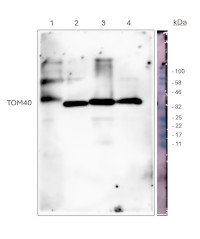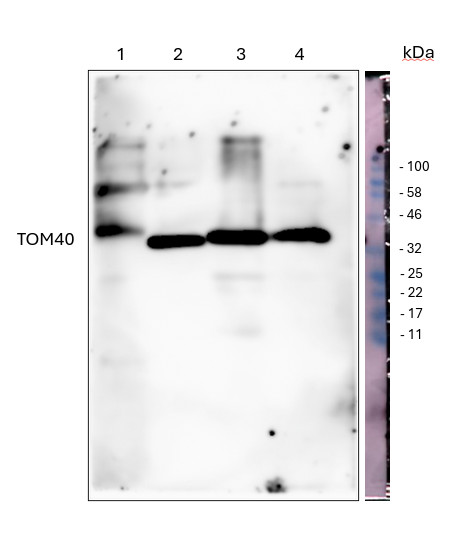1

Anti-TOM40-1/2 | Mitochondrial import receptor subunit TOM40-1/2
AS22 4845 | Clonality: Polyclonal| Host: Rabbit | Reactivity: Arabidopsis thaliana, Oryza sativa, Pisum sativum
- Product Info
-
Immunogen: KLH-conjugated, unique peptide derived from Arabidopsis thaliana TOM40-1 and TOM40-2 protein sequence. UniProt: Q9LHE5, Q9SX55 TAIR: AT1G50400, At1g50400 Host: Rabbit Clonality: Polyclonal Purity: Antigern affinity purified serum, in PBS pH 7.4 Format: Lyophilized Quantity: 50 µg Reconstitution: For reconstitution add 50 µl, of sterile or deionized water. Storage: Store lyophilized/reconstituted at -20°C; once reconstituted make aliquots to avoid repeated freeze-thaw cycles. Please, remember to spin tubes briefly prior to opening them to avoid any losses that might occur from lyophilized material adhering to the cap or sides of the tubes. Tested applications: Western blot (WB) Recommended dilution: 1 : 500 - 1: 2000 (WB) Expected | apparent MW: 32.5 | 34.6 kDa (Depending on isoform) - Reactivity
-
Confirmed reactivity: Arabidopsis thaliana, Oryza sativa, Pisum sativum Predicted reactivity: Brassica napus, Hordeum vulgare, Nicotiana tabacum, Solanum lycopersicum, Solanum tuberosum, Zea mays
Species of your interest not listed? Contact usNot reactive in: No confirmed exceptions from predicted reactivity are currently known - Application Examples
-

Samples:
1 - 50 ug of Oryza sativa seedling isolated mitochondria extract
2 - 50 ug of Pisum sativum seedling isolated mitochondria extract 3 - 50 ug of Arabidopsis thaliana cell culture isolated mitochondria extract
4 - 50 ug of Arabidopsis thaliana seedling isolated mitochondria extract Mark: Blue Protein Standard MW markers 50 µg/well of total protein extracted freshly from the seedlings of Arabidopsis thaliana, Pisum sativum and Oryza sativa. The mitochondria were extracted according to Murcha and Whelan (2015) mitochondria isolation protocol pages 1-12. Samples were separated in the cold on 14 % SDS-PAGE and blotted for 1 h to nitrocellulose (pore size of 0.45 um), using semi-dry method in the cold. Blot was blocked with 10 % skim milk for: 4°C/ON with agitation. Blot was incubated in the primary antibody at a dilution of 1: 500 in 1X TBS-Tween for ON/4°C with agitation. The antibody solution was decanted, and the blot was rinsed briefly twice, then washed once for 15 min and 3 times for 5 min in TBS-T at RT with agitation. Blot was incubated in matching secondary antibody (anti-rabbit IgG horse radish peroxidase conjugated) diluted to 1: 10 000 in 1X TBS-Tween for 1h/RT with agitation. The blot was washed as above and developed with a following chemiluminescent detection reagent. Exposure time was 10 minutes.
Mitochondria were extracted according to the method described here: MURCHA, M. W. & WHELAN, J. 2015. Isolation of Intact Mitochondria from the Model Plant Species Arabidopsis thaliana and Oryza sativa. In: WHELAN, J. & MURCHA, M. W. (eds.) Plant Mitochondria: Methods and Protocols. New York, NY: Springer New York.Courtesy of Valencia Marisa, The University of Western Australia, Australia
- Background
-
Background: TOM40 is the central component of the receptor complex responsible for the recognition and translocation of cytosolically synthesized mitochondrial preproteins. Functions as the transit peptide receptor together with TOM22 , at the surface of the mitochondrion outer membrane and facilitates the movement of preproteins into the translocation pore. TOM40 is directly involved in the pore formation. - Protocols
-
Agrisera Western Blot protocol and video tutorials
Protocols to work with plant and algal protein extracts
Agrisera Educational Poster Collection - Reviews:
-
This product doesn't have any reviews.
Accessories

AS12 1850 | Clonality: Polyclonal | Host: Rabbit | Reactivity: A. thaliana, G.max, S. lycopersicum, T. aestivum, V. faba

AS07 212 | Clonality: Polyclonal | Host: Rabbit | Reactivity: A. thaliana, A. palmeri, S. oleracea, di and monocots | Cellular [compartment marker] of mitochondrial outer membrane


